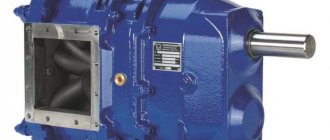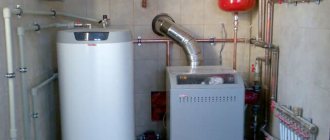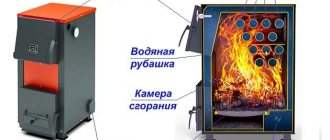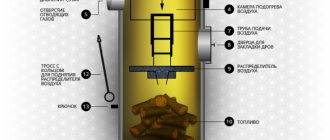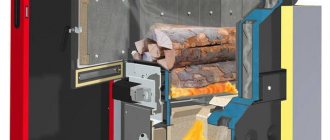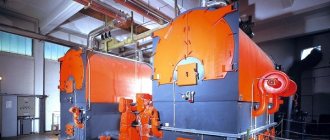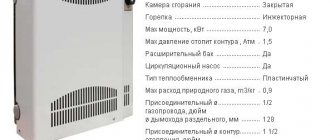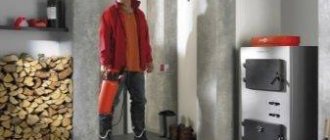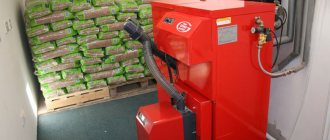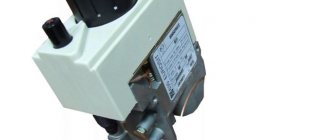What are long-burning coal boilers for private homes?
A long-burning coal boiler is a modern heating device designed to generate thermal energy and subsequently heat the coolant by burning certain types of solid fuel, mainly such as hard and brown coal, anthracite, coal briquettes, etc.
Reference. In fact, the “long-burning” prefix is given to any boiler that can maintain the process of intensive heat generation over a long period: if the boiler burns out on one load of fuel for a day, it receives this status; if it burns out for two days or more, the further status does not change.
Application and effectiveness
Solid fuel boilers do not require advance design of a construction project, so they are used everywhere - not only to create a new one, but also to modernize an existing indoor heating system (domestic, industrial and commercial purposes).
Working on coal does not imply dependence on network communications, so such boilers are ideal for private homes located in non-gasified areas. In such conditions, they most fully reveal their potential, because if desired, they can be adapted for preparing and heating water.
The efficiency of long-burning coal boilers reaches 80–87% (versus the standard 70–75%), but they cannot be called a very cheap heating option.
Comparison of the efficiency of long-burning coal boilers (table):
| Main resource | Heat of combustion, mJ (kW)/kg (m3) | Fuel price, rub./t (m3, kW) | Efficiency | Cost of kW of heat, rubles |
| coal | 22,1 (6,2)–27,6 (7,7) | 6000–7000 | 80–87 % | 1,04–1,20 |
| anthracite coal | 28,3 (7,8)–31,1 (8,7) | 8000–8500 | 80–87 % | 1,12–1,28 |
| natural gas | 33,5 (9,3)–36,5(10) | 5400–5700 | 90–95 % | 0,60–0,64 |
| chopped firewood | 11,2 (3,1)–14,3 (4,0) | 1500–1800 | 60–65 % | 0,69–0,80 |
| electricity | 3,6 (1) | 2.5–4.3 (tariff) | 98–99 % | 2,55–4,34 |
As can be seen from the table, the most profitable from a financial point of view are gas boilers. When burned, gas is almost completely converted into thermal energy, so there is no need to “waste” the waste that is inevitably generated when burning any solid fuel.
The cost of firewood is also lower than coal, but in the long term such heating still loses: since wood has lower density and mass, then with the same volume of the firebox, a full load of firewood (even taking into account the increase in burning time) lasts for 8–48 hours, and coal burns up to 1–7 days.
Thus, we can summarize the following: in the absence of access to the main gas pipeline, a long-burning coal boiler is a very good option for heating a small private house (100–150 m2), especially since in comparison with an electric one it will indeed be much more economical.
Design and principle of operation
The operating principle of a long-burning coal boiler using the example of the Stropuva S20 model.
The design of long-burning coal boilers is generally similar to any other solid fuel units, but it has some features:
- loading chamber - occupies almost the entire internal space of the cylindrical body, which explains the increased capacity of the boiler;
- the entrance to the firebox is necessarily located in the upper third of the loading chamber, while the door itself can be located both vertically and horizontally;
- the air chamber is also a recuperator, due to which the air in it heats up and enters the combustion zone already hot;
- movable distributor - is a flat metal “pancake” necessary for dosing air on the fuel combustion surface;
- telescopic air duct - looks like a dynamically extending tube that connects the air chamber and the distributor;
- ash pan - is placed as standard in the lower part of the body, but no longer plays the role of a ash pan, as in conventional boilers, and therefore must be hermetically sealed;
- chimney channel - has a “broken” (knee) shape, so the smoke passing through it better accumulates heat and is discharged into the chimney already cooled;
- heat exchanger - “water jacket” is built into the boiler body; it (unlike the coil) surrounds the combustion chamber and the chimney duct along the entire perimeter.
Reference. The design of long-burning pyrolysis-type boilers also provides for the presence of a secondary “afterburning” chamber of hot exhaust (flue) gases. A place is allocated for it in the upper part of the primary combustion chamber or the entire housing. The efficiency of such coal boilers increases to 90–95%.
At first glance, it may seem that a long period of continuous operation is achieved by increasing the loading chamber, but this is not entirely true.
The operating principle of such boilers is to implement “top combustion”: for this, air is supplied not from below - through a grate, as in conventional boilers (direct combustion), which operate on natural draft, but from above - through an air duct, using forced flow injection.
Under such conditions, the combustion process becomes completely controllable: it is active only in the air supply zone and almost does not affect the bulk of the fuel. In fact, combustion is reduced to layer-by-layer smoldering (without flame) - from the upper layers to the lower layers, which ensures more uniform heat transfer.
Visual process of long-term burning of coal.
Boilers with a burning duration of one load of fuel up to 7 days
Reviews of domestic long-burning coal boilers: advantages and disadvantages
Considering the complexity of installing a heating system and its cost, it is better not to make mistakes in this matter. To do this, it is important to consider in advance all the pros and cons of long-burning technology, focusing not only on the promises of manufacturers, but also on reviews of real owners of such boilers.
Advantages and disadvantages of long-burning coal boilers:
| Advantages | Flaws |
| saving resources - coal consumption per month is 20–30% lower than in conventional boilers | impossibility of refueling - you will have to wait for the fuel to completely burn out |
| autonomy - most models do not require access to electricity | continuity of the process - even after stopping work, smoldering will continue |
| easy maintenance – cleaning is not required as often and takes less time | allocation of a boiler room - the unit must be installed in a separate room |
| temperature stability – constant monitoring eliminates system overheating | large dimensions - both the boiler and the bunker (optional) take up a lot of space |
| maintaining the environment - smoke, coal dust, etc. do not accumulate in the room. | low operating pressure - maximum 1.6–1.8 bar (traditional 3–4 bar) |
| reliability – the simple design of the boiler guarantees protection from frequent breakdowns | high price - the boiler itself is 1.5–2 times more expensive than usual + additional. equipment |
The high cost of a long-burning boiler is offset over time by saving coal: thus, its installation pays for itself within 5–6 years.
The main feature of heating boilers with an upper combustion method
Considering the difficulties with servicing solid fuel heating devices, manufacturers decided not only to use new technologies in the design of heating equipment, but also to return to traditional technologies. The main task that was solved in the process of modernizing boiler equipment was to increase the burning time of fuel per load. This result was achieved through the use of the top combustion principle in solid fuel boilers.
The technology of boiler operation due to top combustion is not something fundamentally new. Fuel loaded into the firebox burns from top to bottom. Those. on the contrary, not like in traditional type boilers. Combustion begins from the topmost layer, where the required air flow is supplied through a movable distributor. As the fuel mass burns, the air distributor moves down under its own weight, ensuring combustion of the next layer. The loaded fuel thus burns evenly layer by layer, releasing a large volume of combustible wood gas.
At this stage, the temperature in the furnace of the unit reaches 450 0 C.
At this stage, the principle of pyrolysis comes into play. The smallest combustion products, together with the emitted wood gas, completely burn, releasing a huge amount of thermal energy. As a result of the operation of the unit, there is practically no fuel residue left in the combustion chamber.
For reference: Pyrolysis is an exothermic reaction, as a result of which, under the influence of high temperature, the process of decomposition of organic compounds occurs, followed by the release of a flammable gaseous substance. The main heating of a solid fuel boiler during the combustion process is carried out by burning wood gas.
Wood (pyrolysis) gas enters the second chamber through a metal disk, where it ignites due to the forced hot air. The combustion temperature in the second furnace reaches enormous values at this moment, 500-800 0 C. Everything is simple and clear. The main thing is the design of the heating apparatus.
The combustion rate of the fuel depends on the combustion process. In classic-type heating equipment, wood is burned quickly enough, producing the maximum possible heat within a short period of time. In other words, for a short period the unit reaches the peak of its power, after which, without subsequent addition of fuel, the boiler begins to lose load. Constantly loading a new portion of firewood is not always convenient or physically possible. Solid fuel boilers with top loading work completely differently. One load with such a device can be enough for 12, 24 or more hours of operation. The intensity of combustion depends on the load on the heating system.
Everything is simple and clear. The main thing is the design of the heating apparatus.
Which one to choose: details about the characteristics worth paying attention to
Initially, you need to choose a long-burning coal boiler based on the characteristics of the heated room (heat loss, area, installation capabilities, region), because in case of an error, you will have to change not only the equipment, but also the entire piping, which will entail additional time and money costs.
It would be wise to study in advance the types of devices on the market, as well as understand what characteristics make up their price.
Primary heat exchanger (housing) material
The material from which the primary heat exchanger is made primarily determines the reliability of the system, service life and maintainability of the boiler:
- steel – withstands temperature changes well, but is prone to corrosion;
- cast iron is durable (service life is at least 25 years), it cools down longer, continuing to heat the coolant, but does not tolerate fluctuations in temperature and pressure.
A damaged steel body (4 mm thick) is easily repaired (welded), but brittle cast iron, even with the slightest crack, must be replaced.
Model LIEPSNELE L20U. The cast iron heat exchanger and loading door are housed in a brown steel housing.
Many manufacturers combine the strengths of both metals: for example, they produce boilers in a steel casing with a cast iron combustion chamber.
Single-circuit or double-circuit
Depending on the number of circuits, long-burning coal boilers can distribute the generated heat to solve one or several problems:
- single-circuit - designed exclusively for heating the room, it connects directly to the batteries (radiators) and heats water only for them;
- double-circuit - has an auxiliary heat exchanger, which is responsible for providing hot water supply and heating water for the underfloor heating system.
Reference. The power of the flow heater used as a heat exchanger must be constantly adjusted in accordance with the water flow.
Since the combustion intensity of solid fuel cannot be changed in real time, the benefit of a coal boiler with a water circuit is very doubtful . In addition, two heat exchangers cannot operate simultaneously, and frequent switching leads to accidental breakdowns and wear of the equipment.
It makes more sense to connect an indirect heating boiler to a single-circuit boiler, which will work like a conventional storage water heater.
Using a long-lasting boiler Stropuva S15 (right) in conjunction with an indirect heating boiler (left).
Minimum required power and heated area
The contractor that will carry out the installation work should help you choose the right power for a long-burning coal boiler.
However, you can make an approximate calculation yourself using the formula:
Q = S × 100 , where
- Q is the required power required to heat the room (kW);
- S – heated area (m²);
- 100 – power rate per unit area (W/m²).
For example, for a house with an area of 120 m², Q=120×100=12000 W ≈ 12 kW.
The manufacturer indicates the power for the most calorific type of coal intended as the main fuel. In order to avoid operating the equipment at its maximum capacity when using other types of fuel, it is recommended to add a margin of 10–20%, Q ≈ 14 kW, to the obtained value.
How to calculate the required boiler power Individual calculation, formula and correction factors
Efficiency
The efficiency factor allows you to determine the efficiency of using energy resources in relation to the amount of useful heat generated by the unit; accordingly, the higher this indicator, the better. However, first of all you need to think about the rationality of the choice.
Long-burning boilers have an efficiency of 80–87%. A difference of 1–2% will not significantly reduce fuel consumption, but prices for “ideal” models can be prohibitively high, so if you have a limited budget, you can safely purchase a more modest option (rounded down).
How and what kind of coal is best to heat a household solid fuel boiler
Other important selection criteria
When choosing a long-burning boiler, you should also pay attention to other characteristics on which the convenience of further operation depends:
- degree of automation - semi-automatic boilers are loaded manually, after which ignition and combustion support occurs automatically, and automatic devices have a hopper, which also automates the fuel supply;
- energy dependence - automatic long-burning coal boilers require a constant connection to the electrical network, and boilers with thermomechanical control can operate uninterruptedly even without access to electricity;
- volume of the loading chamber - the size of the firebox must correspond to the power, the optimal figure is 3.3–5.1 l/kW (for example, for a 25 kW boiler with a 110 l chamber it will be equal to 110/25 = 4.4 l/kW, which considered normal);
- other types of fuel - almost all coal boilers can be heated with wood and pressed briquettes, but some models are even more versatile, i.e., if desired, you can put a pellet or even gas burner on them;
- control and functionality - the equipment is equipped with a thermostat, weather-dependent automation, a self-cleaning system and a GSM module, as well as safety elements (emergency switch, blast valve, etc.).
You need to pay special attention to the last point, since most often breakdowns occur precisely because of insufficient emergency equipment.
How to choose the right boiler connection diagram
In order to keep the house warm, it is not enough to know what heating schemes are available with a solid fuel boiler. Craftsmen who have been creating heating systems for many years give the following recommendations:
- When creating a drawing of a heating circuit for a solid fuel boiler, you should first familiarize yourself with the types and operating principles of such heat generators. This can be a constant or long-burning heater, a pyrolysis or pellet unit, or a buffer. Each of these devices has its own operating criteria, which may be disadvantages for some, and advantages for others.
- To get an ideal heat supply scheme, you need to be able to combine the functioning of the boiler with the tank, since this element accumulates thermal energy. This is justified by the fact that the element heating the water can change its temperature in the range from 60 to 90 degrees. There is no constant indicator. Since solid fuel boilers are inert devices, this distinguishes them favorably from gas, diesel and electric analogues.
- When choosing a heating scheme, you need to objectively assess the risk of power outages. If there are frequent power outages in the area, then a system with a water pump will not only not pay for itself, but may quickly fail. Therefore, it is better to choose a type of heating with natural circulation.
- When choosing a piping, it is worth considering in advance the safety lines between the boiler and the tank. They are located at the points of the inlet and outlet pipes so that they are as close as possible to the water heater. Also, to achieve maximum effect, you need to try to keep the distance between the boiler and expansion tank to a minimum. But it is no longer possible to install safety valves or taps here.
- If a scheme with a pump was chosen, then it is installed on the return pipe, as close as possible to the heat generator. Thus, even if the lights are turned off and the pump stops working, the water will continue to move along the circuit, that is, minimal heat will be retained. The device must be installed along a bypass route. Only then will it be possible to disconnect it from the network (if necessary), and shut off the circuit itself using taps.
- There is such a thing as bypass. These are jumpers with taps that are placed between the supply line and the return pipe. This arrangement facilitates the return of “extra” hot water when the volume changes through the thermostat.
- A stainless steel valve must be installed in the chimney pipe. Since there is moisture in the smoke, albeit in small quantities, it is this that can provoke the destruction of the internal part.
Tying is a process that deserves special attention. Therefore, they design and install it only if they have complete confidence in their abilities. Nikolay Avramenko, 51 years old
Energodar
Nikolay Avramenko, 51 years old, Energodar
Having read the article, I would like to add my note. The topic of operational characteristics of solid fuel boilers was touched upon here. It was indicated that they have such a feature as high inertia. I would like to say that this phenomenon is not typical for pellet boilers. This is due to the fact that such devices have a burner that receives wood pellets in portions. Therefore, when the supply of raw materials stops, the flame immediately goes out. Although such boilers are not so cheap.
089aaee8336b4ccb28c7183ac916ddfa.jpe
Anton Abramov, 29 years old, Omsk
At one time, I was interested in the work of solid fuel boilers, as they offered me a position related to this area. I would like to leave a few words about the thermostat and its regulatory features. You need to understand that when a certain temperature is set, for example, at 85 degrees, even though the damper is closed, the burning and smoldering continues. Because of this, the water still heats up a couple of degrees, and only then it will be established accurately. Therefore, you should not turn the thermostat back and forth, otherwise this may lead to breakdown of the entire system.
Nikita Karpenko, 37 years old, Arkhangelsk
When we built a house outside the city, we planned to live there all year round. The time came when it came to heating, and I settled on a closed-type system with natural circulation. Firstly, it was quite easy for me to create it with my own hands, and secondly, we were already a little limited in money. I didn’t have any particular problems with the installation, but when the first cold weather arrived, I realized that there was clearly not enough heat for the house. So at school, I was quite good at physics, and I realized that heat is “lost” in areas where the pipes were left open. Taking a roll of mineral wool, I wrapped all the pipes that run in open areas. Literally by the end of the first day, our family felt a significant warming in the rooms. Therefore, you need to remember such moments.
The best known manufacturers and models: characteristics and prices
Stropuva S15U
Stropuva (Stropuva) S15U with a power of 15 kW is a universal mine-type boiler that runs not only on coal, but also on wood, pellets and briquettes from any material. It is equipped with a bimetallic traction control, which eliminates the need to connect to the electrical network. Suitable for houses with an area of 100–120 m2.
Cost : 81,500–99,770 rubles.
Country of origin : Russia–Lithuania, STROPUVA LLC (STROPUVA).
Heiztechnik Q Alfa 15
Heiztechnik (Haytstechnik) Q Alfa 15 with a power of 15 kW - designed for heating a room with an area of 110–130 m2, burns coal, wood chips, various wood and briquettes. This Polish boiler is distinguished by a combination of cast iron grates and a body made of thick boiler steel (5 mm), which guarantees a long service life - up to 20 years.
Cost : 62,240–68,720 rubles.
Country of origin : Poland, HEIZTECHNIK LLC (HEIZTECHNIK).
Buderus Logano S181-15E
Buderus Logano S181-15E with a power of 15 kW is one of the best long-burning coal boilers for heating a private house with an area of 120–140 m2. The basic package includes water and gas temperature sensors, as well as a spacious hopper (240 l), thanks to which the device operates for 3-5 days in a row.
Cost : 218,000–250,640 rubles.
Country of origin : Germany, BOSCH LLC (BOSH THERMOTECHNIKA).
WEEK KO-60
WEEK KO-60 with a power of 60 kW is a highly efficient domestically produced model capable of heating a house of 200–250 m2 for 2–4 days using one bed of coal. Its microprocessor unit is not sensitive to power failures, and when turned off, the boiler simply goes out slowly (6–12 hours).
Cost : 115,900–130,500 rubles.
Country of origin : Russia (Kemerovo), TRIAY LLC.
TIS PRO 11
TIS (TIS) PRO 11 with a power of 11 kW is a compact unit that is well suited for heating a small private house, cottage or cottage of 80–100 m2. Air supply adjustment can be manual (using a bolt on the door) or automatic (using a mechanical thermostat) - your choice.
Cost : 64,100–67,200 rubles.
Country of origin : Belarus, BelKomin LLC TIS Group (TIS Group).
LIEPSNELE L20U
LIEPSNELE (Liepsnele) L20U with a power of 20 kW is a non-volatile boiler for a house of 150–180 m2, has a capacious loading chamber (320 l), which ensures the burning duration of one load of up to 6–7 days. It is practically “omnivorous”: it can be heated with coal, wood, sawdust, shavings, pellets and even peat.
Cost : 85,400–90,560 rubles.
Country of origin : Lithuania, LLC "VAKARO RASA" (VAKARO RASA).
How to heat so that coal burns as long as possible
The correct firing of a long-lasting coal boiler largely depends on the presence of control automation and, of course, the quality of the coal itself.
What coal is better to use
Manually operated boilers can operate on coal of any fraction. But it must be taken into account that the temperature of the gases in the chimney during long-term combustion is much lower than during direct combustion: the use of raw fuel can lead to the accumulation of excess moisture in the pipe and the formation of condensation - a black viscous liquid with a tar smell. Therefore, the relative humidity of coal (like any other solid fuel) should be no more than 15–20%.
Reference. Equipment with an automatic fuel supply function is more sensitive to the fraction, since it was originally developed for the 5–25 mm standard. In addition, it should be heated with low-caking (type 31 or 32) and low-ash (up to 15%) coal to avoid the appearance of excess “garbage” and a decrease in efficiency.
Correct firebox
The combustion of a long-burning boiler is carried out according to the following scheme:
- Fuel loading - the distributor is raised to its original position so that it is just above the loading door, and all the coal is immediately poured.
- Kindling - dry wood chips and paper are placed on top of the coal, after which they are ignited and burn with the top door open and the air duct closed.
- Combustion - when the temperature in the heat exchanger reaches 50-60 °C, the door closes tightly, then the telescopic air duct regulator opens.
- Temperature adjustment - the boiler automatically enters the optimal mode, but if necessary, the temperature is adjusted by the air duct damper.
Upon completion of the full combustion cycle, it is necessary to remove sintered pieces of coal from the loading chamber, clean the ash pan and fill in a new batch of fuel.
Recommendations for use
When installing a boiler, attention should first of all be paid to the quality of the chimney. Stainless steel pipes with a diameter of 120 to 200 mm (depending on the model) are best suited for it.
The ideal option would be a finished pipe with thermal insulation - a sandwich. Pipes with thick walls are not recommended. They take longer to warm up, and soot remains on the walls. It is necessary to clean the chimney once every 2 months.
When the boiler is turned on for the first time, an unpleasant odor may appear. Don't worry - this is normal, as special oil is applied to the metal during production. The first combustion should begin in a ventilated room, and the boiler should be turned on at maximum power. The duration of its operation in this mode is 1 hour.
The fuel is placed in the chamber in a loose layer so that there is an air gap between the firewood. This will allow them to ignite better. To control the combustion process in the ash chamber, the damper opens and closes.
Cleaning the boiler is allowed only after it has completely cooled down. During cleaning, it is recommended to leave some of the ash on the grate, which will serve as natural thermal insulation. This will extend the life of the element. To clean the boiler itself, use a wire brush or scraper. The smoke damper must be open at this time.
80f3086a9836111a624430b1379de635.jpe
Depending on what fuel is used, a certain amount of soot is formed during boiler operation. Coniferous wood produces more waste. Sometimes condensation may form in the chimney: this depends on the level of thermal insulation and the moisture content of the fuel. To reduce the soot layer, it is recommended to use aspen firewood.
Prices: summary table
Price rating of long-burning coal boilers (table):
| Long burning coal boiler model | Cost, rub. |
| Stropuva S15U | 85 400–90 560 |
| Heiztechnik Q Alfa 15 | 62 240–68 720 |
| Buderus Logano S181-15E | 218 000–250 640 |
| WEEK KO-60 | 115 900–130 500 |
| TIS (TIS) PRO 11 | 64 100–67 200 |
| LIEPSNELE L20U | 81 500–99 770 |
| VIADRUS Hercules U22D | 126 600 –128 530 |
| Galmet CARBO 21 | 103 890–116 750 |
Where to buy a long-burning coal boiler for heating a private home
In Moscow
- Stoves-Fireplaces – st. Yubileinaya, 4 building A, tel. +7 (495) 215–56–94.
- Comfort - Dmitrovskoe highway, 100, building 2, tel. +7 (495) 921–37–61.
In St. Petersburg
- TechnoDom - 57 Stachek Ave., Komsomolskaya Square, tel. +7 (812) 671–00–88.
- Kit-Teplo - st. Litovskaya 8, +7 (812) 295–00–05, +7 (812) 248–18–88.
In conclusion, it is worth saying that the efficiency and economy of the heating system depends not least on the skill of the user, therefore, in order for a long-burning coal boiler to serve well for more than one season, it is necessary to learn how to properly operate the equipment and care for it.
Long burning boilersSolid fuel boilersCoal boilers
